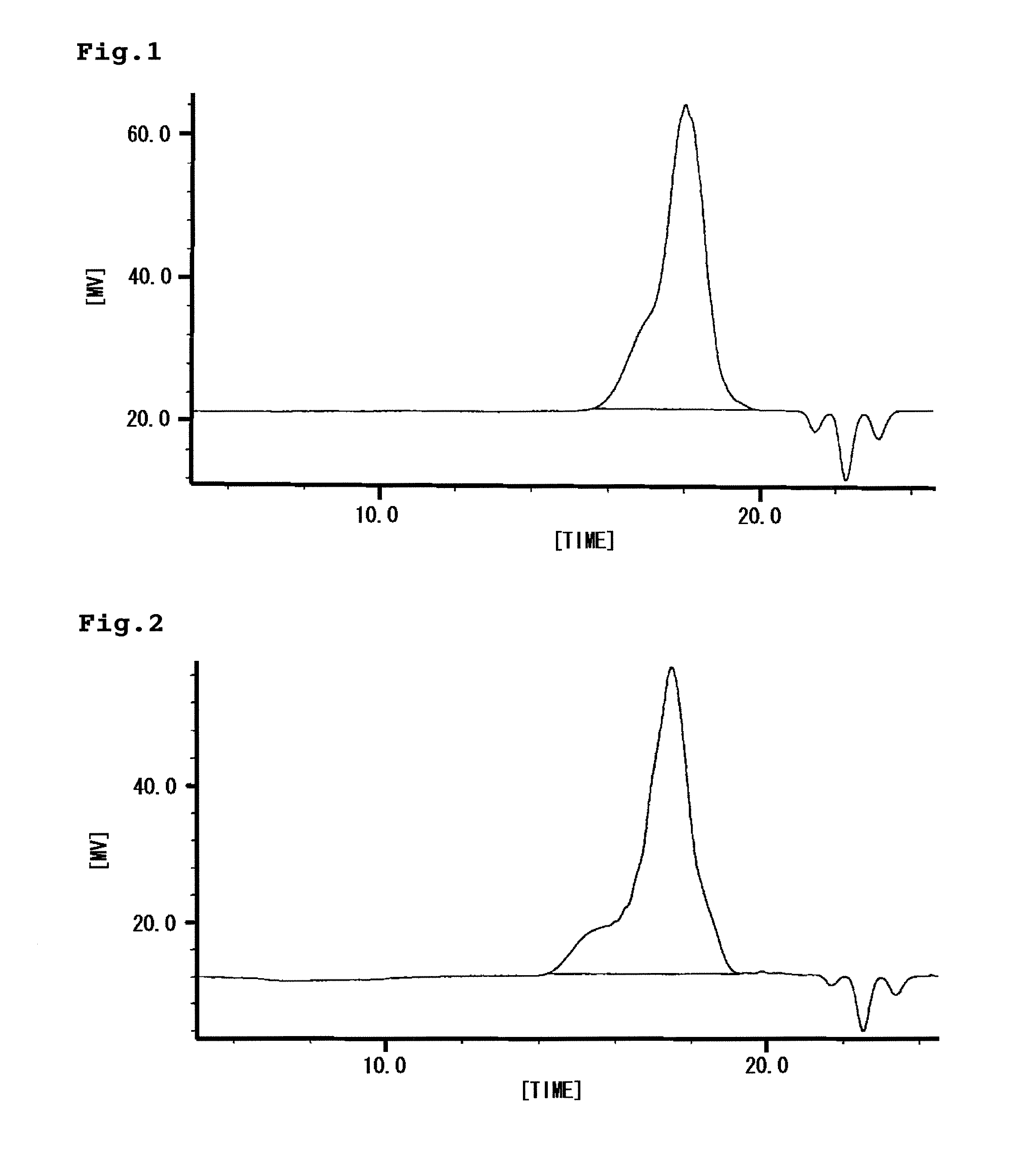Polyorganosiloxane And Curable Composition Containing Same
a polyorganosiloxane and composition technology, applied in the field of polyorganosiloxane and a curable composition containing the same, can solve the problems of long time dependence, easy crack destruction, and product britishness, and achieve excellent ultraviolet-ray transparency and heat resistance, excellent curability, and excellent resistance to cracks by cyclic heat-cooling
- Summary
- Abstract
- Description
- Claims
- Application Information
AI Technical Summary
Benefits of technology
Problems solved by technology
Method used
Image
Examples
example 1-1
[0094] 100 ml of methylethylketone, 16.03 g (50 mmol) of 3-(3-methyl-3-oxetanemethoxy)propyl triethoxysilane (hereinafter, referred to “OXe-TRIES”.) represented by the following formula (6), 44.58 g (250 mmol) of methyl triethoxysilane, 8.12 g (50 mmol) of hexamethyldisiloxane and 53.05 g of polyethylene glycol (product name “polyethylene glycol #400”, manufactured by Wako Pure Chemical Industries Corporation, weight average molecular weight; 400) were charged into a reactor provided with a stirrer and a thermometer, and then 19.0 g of 1% hydrochloric acid (H2O; 1.05 mol, HCl; 4 mmol) was gradually added slowly and stirred at 40° C. The progress of the reaction was observed by GPC. When almost OXe-TRIES were disappeared (8 hours later from starting addition of the mixture), the reaction was finished. After that, a solvent was eliminated under reduced pressure to obtain a colorless and transparent resin having viscosity of 2,500 mPa at 25° C. (hereinafter, referred to “resin A1”.). T...
example 1-2
[0095] 100 ml of methylethylketone, 16.03 g (50 mmol) of the aforementioned OXe-TRIES, 44.58 g (250 mmol) of methyl triethoxysilane, 8.12 g (50 mmol) of hexamethyldisiloxane and 53.05 g of polytetramethylene glycol (product name “polytetramethylene glycol #1500”, manufactured by Wako Pure Chemical Industries Corporation, weight average molecular weight; 1,500) were charged into a reactor provided with a stirrer and a thermometer, and then 19.0 g of 1% hydrochloric acid (H2O; 1.05 mol, HCl; 4 mmol) was gradually added slowly and stirred at 40° C. The progress of the reaction was observed by GPC. When almost OXe-TRIES were disappeared (8 hours later from starting addition of the mixture), the reaction was finished. After that, a solvent was eliminated under reduced pressure to obtain a colorless and transparent resin having viscosity of 4,600 mPa at 25° C. (hereinafter, referred to “resin A2”.). The weight average molecular weight of this resin A2 by GPC was 4,500.
[0096] Molecular we...
example 2-1
[0099] 60 parts by mass of the “resin A1” obtained in the aforementioned Example 1-1, 40 parts by mass of caprolactone-modified 3,4-epoxycyclohexylmethyl-3,4-epoxycyclohexyl carboxylate represented by the following formula (7) as a cationic polymerizable monomer and 0.2 part by mass of a thermal polymerization initiator (product name “ADEKA OPTON CP-66” manufactured by Adeka Corp.) were mixed using a disper for 15 minutes. After that, defoaming was performed to a heat-curable composition.
[0100] A cured product was obtained using the aforementioned heat-curable composition, and various evaluations were conducted by the following method. The results are shown in Table 1.
(1) Transmittance of Ultraviolet-Ray
[0101] A heat-curable composition was poured to a molding which is made of a fluorine resin and whose size is 50 mm×50 mm×3 mm depth and was heated at 150° C. for one hour to obtain a cured product. This cured product was set for 24 hours in a temperature-controlled room whose t...
PUM
| Property | Measurement | Unit |
|---|---|---|
| Temperature | aaaaa | aaaaa |
| Temperature | aaaaa | aaaaa |
| Temperature | aaaaa | aaaaa |
Abstract
Description
Claims
Application Information
 Login to View More
Login to View More - R&D
- Intellectual Property
- Life Sciences
- Materials
- Tech Scout
- Unparalleled Data Quality
- Higher Quality Content
- 60% Fewer Hallucinations
Browse by: Latest US Patents, China's latest patents, Technical Efficacy Thesaurus, Application Domain, Technology Topic, Popular Technical Reports.
© 2025 PatSnap. All rights reserved.Legal|Privacy policy|Modern Slavery Act Transparency Statement|Sitemap|About US| Contact US: help@patsnap.com



